This is an old revision of this page, as edited by OAbot (talk | contribs) at 17:33, 29 January 2023 (Open access bot: doi added to citation with #oabot.). The present address (URL) is a permanent link to this revision, which may differ significantly from the current revision.
Revision as of 17:33, 29 January 2023 by OAbot (talk | contribs) (Open access bot: doi added to citation with #oabot.)(diff) ← Previous revision | Latest revision (diff) | Newer revision → (diff) Cauldron-like volcanic feature formed by the emptying of a magma chamber For other uses, see Caldera (disambiguation).

A caldera (/kɔːlˈdɛrə, kæl-/ kawl-DERR-ə, kal-) is a large cauldron-like hollow that forms shortly after the emptying of a magma chamber in a volcano eruption. When large volumes of magma are erupted over a short time, structural support for the rock above the magma chamber is gone. The ground surface then collapses into the emptied or partially emptied magma chamber, leaving a large depression at the surface (from one to dozens of kilometers in diameter). Although sometimes described as a crater, the feature is actually a type of sinkhole, as it is formed through subsidence and collapse rather than an explosion or impact. Compared to the thousands of volcanic eruptions that occur each century, the formation of a caldera is a rare event, occurring only a few times per century. Only seven caldera-forming collapses are known to have occurred between 1911 and 2016. More recently, a caldera collapse occurred at Kīlauea, Hawaii in 2018.
Etymology
The term caldera comes from Spanish Template:Wiktes, and Latin Template:Wiktla, meaning "cooking pot". In some texts the English term cauldron is also used, though in more recent work the term cauldron refers to a caldera that has been deeply eroded to expose the beds under the caldera floor. The term caldera was introduced into the geological vocabulary by the German geologist Leopold von Buch when he published his memoirs of his 1815 visit to the Canary Islands, where he first saw the Las Cañadas caldera on Tenerife, with Mount Teide dominating the landscape, and then the Caldera de Taburiente on La Palma.
Caldera formation
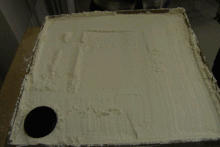
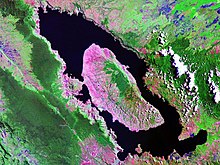
A collapse is triggered by the emptying of the magma chamber beneath the volcano, sometimes as the result of a large explosive volcanic eruption (see Tambora in 1815), but also during effusive eruptions on the flanks of a volcano (see Piton de la Fournaise in 2007) or in a connected fissure system (see Bárðarbunga in 2014–2015). If enough magma is ejected, the emptied chamber is unable to support the weight of the volcanic edifice above it. A roughly circular fracture, the "ring fault", develops around the edge of the chamber. Ring fractures serve as feeders for fault intrusions which are also known as ring dikes. Secondary volcanic vents may form above the ring fracture. As the magma chamber empties, the center of the volcano within the ring fracture begins to collapse. The collapse may occur as the result of a single cataclysmic eruption, or it may occur in stages as the result of a series of eruptions. The total area that collapses may be hundreds of square kilometers.
Mineralization in calderas

Some calderas are known to host rich ore deposits. Metal-rich fluids can circulate through the caldera, forming hydrothermal ore deposits of metals such as lead, silver, gold, mercury, lithium, and uranium. One of the world's best-preserved mineralized calderas is the Sturgeon Lake Caldera in northwestern Ontario, Canada, which formed during the Neoarchean era about 2.7 billion years ago. In the San Juan volcanic field, ore veins were emplaced in fractures associated with several calderas, with the greatest mineralization taking place near the youngest and most silicic intrusions associated with each caldera.
Types of caldera
Explosive caldera eruptions
Further information: Explosive eruptionExplosive caldera eruptions are produced by a magma chamber whose magma is rich in silica. Silica-rich magma has a high viscosity, and therefore does not flow easily like basalt. The magma typically also contains a large amount of dissolved gases, up to 7 wt% for the most silica-rich magmas. When the magma approaches the surface of the Earth, the drop in confining pressure causes the trapped gases to rapidly bubble out of the magma, fragmenting the magma to produce a mixture of volcanic ash and other tephra with the very hot gases.
The mixture of ash and volcanic gases initially rises into the atmosphere as an eruption column. However, as the volume of erupted material increases, the eruption column is unable to entrain enough air to remain buoyant, and the eruption column collapses into a tephra fountain that falls back to the surface to form pyroclastic flows. Eruptions of this type can spread ash over vast areas, so that ash flow tuffs emplaced by silicic caldera eruptions are the only volcanic product with volumes rivaling those of flood basalts. For example, when Yellowstone Caldera last erupted some 650,000 years ago, it released about 1,000 km of material (as measured in dense rock equivalent (DRE)), covering a substantial part of North America in up to two metres of debris.
Eruptions forming even larger calderas are known, such as the La Garita Caldera in the San Juan Mountains of Colorado, where the 5,000 cubic kilometres (1,200 cu mi) Fish Canyon Tuff was blasted out in eruptions about 27.8 million years ago.
The caldera produced by such eruptions is typically filled in with tuff, rhyolite, and other igneous rocks. The caldera is surrounded by an outflow sheet of ash flow tuff (also called an ash flow sheet).
If magma continues to be injected into the collapsed magma chamber, the center of the caldera may be uplifted in the form of a resurgent dome such as is seen at the Valles Caldera, Lake Toba, the San Juan volcanic field, Cerro Galán, Yellowstone, and many other calderas.
Because a silicic caldera may erupt hundreds or even thousands of cubic kilometers of material in a single event, it can cause catastrophic environmental effects. Even small caldera-forming eruptions, such as Krakatoa in 1883 or Mount Pinatubo in 1991, may result in significant local destruction and a noticeable drop in temperature around the world. Large calderas may have even greater effects. The ecological effects of the eruption of a large caldera can be seen in the record of the Lake Toba eruption in Indonesia.
At some points in geological time, rhyolitic calderas have appeared in distinct clusters. The remnants of such clusters may be found in places such as the Eocene Rum Complex of Scotland, the San Juan Mountains of Colorado (formed during the Oligocene, Miocene, and Pliocene epochs) or the Saint Francois Mountain Range of Missouri (erupted during the Proterozoic eon).
Valles
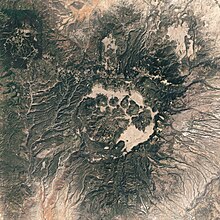
For their 1968 paper that first introduced the concept of a resurgent caldera to geology, R.L. Smith and R.A. Bailey chose the Valles caldera as their model. Although the Valles caldera is not unusually large, it is relatively young (1.25 million years old) and unusually well preserved, and it remains one of the best studied examples of a resurgent caldera. The ash flow tuffs of the Valles caldera, such as the Bandelier Tuff, were among the first to be thoroughly characterized.
Toba
Main articles: Lake Toba and Toba catastrophe theoryAbout 74,000 years ago, this Indonesian volcano released about 2,800 cubic kilometres (670 cu mi) dense-rock equivalent of ejecta. This was the largest known eruption during the ongoing Quaternary period (the last 2.6 million years) and the largest known explosive eruption during the last 25 million years. In the late 1990s, anthropologist Stanley Ambrose proposed that a volcanic winter induced by this eruption reduced the human population to about 2,000–20,000 individuals, resulting in a population bottleneck. More recently, Lynn Jorde and Henry Harpending proposed that the human species was reduced to approximately 5,000–10,000 people. There is no direct evidence, however, that either theory is correct, and there is no evidence for any other animal decline or extinction, even in environmentally sensitive species. There is evidence that human habitation continued in India after the eruption.


Non-explosive calderas
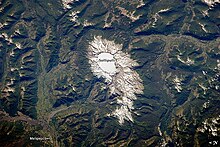
Some volcanoes, such as the large shield volcanoes Kīlauea and Mauna Loa on the island of Hawaii, form calderas in a different fashion. The magma feeding these volcanoes is basalt, which is silica poor. As a result, the magma is much less viscous than the magma of a rhyolitic volcano, and the magma chamber is drained by large lava flows rather than by explosive events. The resulting calderas are also known as subsidence calderas and can form more gradually than explosive calderas. For instance, the caldera atop Fernandina Island collapsed in 1968 when parts of the caldera floor dropped 350 metres (1,150 ft).
Extraterrestrial calderas
Since the early 1960s, it has been known that volcanism has occurred on other planets and moons in the Solar System. Through the use of crewed and uncrewed spacecraft, volcanism has been discovered on Venus, Mars, the Moon, and Io, a satellite of Jupiter. None of these worlds have plate tectonics, which contributes approximately 60% of the Earth's volcanic activity (the other 40% is attributed to hotspot volcanism). Caldera structure is similar on all of these planetary bodies, though the size varies considerably. The average caldera diameter on Venus is 68 km (42 mi). The average caldera diameter on Io is close to 40 km (25 mi), and the mode is 6 km (3.7 mi); Tvashtar Paterae is likely the largest caldera with a diameter of 290 km (180 mi). The average caldera diameter on Mars is 48 km (30 mi), smaller than Venus. Calderas on Earth are the smallest of all planetary bodies and vary from 1.6–80 km (1–50 mi) as a maximum.
The Moon
The Moon has an outer shell of low-density crystalline rock that is a few hundred kilometers thick, which formed due to a rapid creation. The craters of the Moon have been well preserved through time and were once thought to have been the result of extreme volcanic activity, but are currently believed to have been formed by meteorites, nearly all of which took place in the first few hundred million years after the Moon formed. Around 500 million years afterward, the Moon's mantle was able to be extensively melted due to the decay of radioactive elements. Massive basaltic eruptions took place generally at the base of large impact craters. Also, eruptions may have taken place due to a magma reservoir at the base of the crust. This forms a dome, possibly the same morphology of a shield volcano where calderas universally are known to form. Although caldera-like structures are rare on the Moon, they are not completely absent. The Compton-Belkovich Volcanic Complex on the far side of the Moon is thought to be a caldera, possibly an ash-flow caldera.
Mars
Further information: Volcanism on MarsThe volcanic activity of Mars is concentrated in two major provinces: Tharsis and Elysium. Each province contains a series of giant shield volcanoes that are similar to what we see on Earth and likely are the result of mantle hot spots. The surfaces are dominated by lava flows, and all have one or more collapse calderas. Mars has the largest volcano in the Solar System, Olympus Mons, which is more than three times the height of Mount Everest, with a diameter of 520 km (323 miles). The summit of the mountain has six nested calderas.
Venus
Further information: Volcanism on VenusBecause there is no plate tectonics on Venus, heat is mainly lost by conduction through the lithosphere. This causes enormous lava flows, accounting for 80% of Venus' surface area. Many of the mountains are large shield volcanoes that range in size from 150–400 km (95–250 mi) in diameter and 2–4 km (1.2–2.5 mi) high. More than 80 of these large shield volcanoes have summit calderas averaging 60 km (37 mi) across.
Io
Further information: Volcanism on IoIo, unusually, is heated by solid flexing due to the tidal influence of Jupiter and Io's orbital resonance with neighboring large moons Europa and Ganymede, which keep its orbit slightly eccentric. Unlike any of the planets mentioned, Io is continuously volcanically active. For example, the NASA Voyager 1 and Voyager 2 spacecraft detected nine erupting volcanoes while passing Io in 1979. Io has many calderas with diameters tens of kilometers across.
List of volcanic calderas
See also: Category:Calderas- Africa
- Ngorongoro Crater (Tanzania)
- Menengai Crater (Kenya)
- Mount Elgon (Uganda/Kenya)
- Mount Fogo (Cape Verde)
- Mount Longonot (Kenya)
- Mount Meru (Tanzania)
- Erta Ale (Ethiopia)
- Nabro Volcano (Eritrea)
- Mallahle (Eritrea)
- See Europe for calderas in the Canary Islands
- Americas
- Argentina
- Bolivia
- United States

Crater Lake, Oregon, formed around 5,680 BC 
Aniakchak-caldera, Alaska - Mount Aniakchak (Aniakchak National Monument and Preserve) (Alaska)
- Crater Lake on Mount Mazama (Crater Lake National Park, Oregon)
- Mount Katmai (Alaska)
- Kīlauea (Hawaii)
- Mauna Loa (Hawaii)
- La Garita Caldera (Colorado)
- Long Valley (California)
- Henry's Fork Caldera (Idaho)
- Island Park Caldera (Idaho, Wyoming)
- Newberry Volcano (Oregon)
- McDermitt Caldera (Oregon)
- Medicine Lake Volcano (California)
- Mount Okmok (Alaska)
- Valles Caldera (New Mexico)
- Yellowstone Caldera (Wyoming)
- Canada
- Silverthrone Caldera (British Columbia)
- Mount Edziza (British Columbia)
- Bennett Lake Volcanic Complex (British Columbia/Yukon)
- Mount Pleasant Caldera (New Brunswick)
- Sturgeon Lake Caldera (Ontario)
- Mount Skukum Volcanic Complex (Yukon)
- Blake River Megacaldera Complex (Quebec/Ontario)
- New Senator Caldera (Quebec)
- Misema Caldera (Ontario/Quebec)
- Noranda Caldera (Quebec)
- Colombia
- Arenas crater caldera, Nevado del Ruiz volcano, Caldas Department
- Laguna Verde caldera, Azufral volcano, Narino Department
- Mexico
- Chile
- Ecuador
- El Salvador
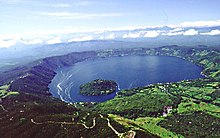
Coatepeque Caldera, El Salvador crater lake - Guatemala
- Other
- Masaya (Nicaragua)
- Asia
- East Asia
- Dakantou Caldera (大墈头) (Shanhuyan Village, Taozhu Town, Linhai, Zhejiang, China)
- Ma'anshan Caldera (马鞍山) (Shishan Town (石山镇), Xiuying, Hainan, China)
- Yiyang Caldera (宜洋) (Shuangxi Town (双溪镇宜洋村), Pingnan County, Fujian, China)
- Aira Caldera (Kagoshima Prefecture, Japan)
- Kussharo (Hokkaido, Japan)
- Kuttara (Hokkaido, Japan)
- Mashū (Hokkaido, Japan)
- Aso Caldera, Mount Aso (Kumamoto Prefecture, Japan)
- Kikai Caldera (Kagoshima Prefecture, Japan)
- Towada (Aomori Prefecture, Japan)
- Tazawa (Akita Prefecture, Japan)
- Hakone (Kanagawa Prefecture, Japan)
- Mount Halla (Jeju-do, South Korea)
- Heaven Lake (Baekdu Mountain, North Korea/Changbai Mountains, China)
- Southeast Asia

Mount Pinatubo, Philippines - Apolaki Caldera (Benham Rise, Philippines)
- Corregidor Caldera (Manila Bay, Philippines)
- Mount Pinatubo (Luzon, Philippines)
- Taal Volcano (Luzon, Philippines)
- Laguna Caldera (Luzon, Philippines)
- Irosin Caldera (Luzon, Philippines)
- Batur (Bali, Indonesia)
- Krakatoa (Sunda Strait, Indonesia)
- Lake Maninjau (Sumatra, Indonesia)
- Lake Toba (Sumatra, Indonesia)
- Mount Rinjani (Lombok, Indonesia)
- Mount Tondano (Sulawesi, Indonesia)
- Mount Tambora (Sumbawa, Indonesia)
- Tengger Caldera (Java, Indonesia)
- Southwest Asia
- Derik (Mardin, Turkey)
- Nemrut (volcano) (Turkey)
- Russia
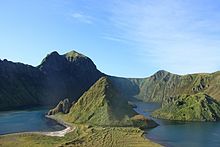
Caldera of the island Yankicha/Ushishir, Kuril Islands - Akademia Nauk (Kamchatka Peninsula)
- Golovnin (Kuril Islands)
- Karymsky Caldera (Kamchatka Peninsula)
- Karymshina (Kamchatka Peninsula)
- Khangar (Kamchatka Peninsula)
- Ksudach (Kamchatka Peninsula)
- Kurile Lake (Kamchatka Peninsula)
- Lvinaya Past (Kuril Islands)
- Tao-Rusyr Caldera (Kuril Islands)
- Uzon (Kamchatka Peninsula)
- Zavaritski Caldera (Kuril Islands)
- Yankicha/Ushishir (Kuril Islands)
- Chegem Caldera (Kabardino-Balkarian Republic, North Caucasus)
- East Asia
- Europe

3D CGI aerial spinning view over Santorini, Greece 
Aerial view of the Laacher See, Germany Caldeira do Faial on the Caldeira Volcano, Faial Island, Azores - Banská Štiavnica (Slovakia)
- Bakuriani/Didveli Caldera (Georgia)
- Samsari (Georgia)
- Santorini (Greece)
- Nisyros (Greece)
- Askja (Iceland)
- Grímsvötn (Iceland)
- Bárðarbunga (Iceland)
- Katla (Iceland)
- Krafla (Iceland)
- Phlegraean Fields (Italy)
- Lake Bracciano (Italy)
- Lake Bolsena (Italy)
- Mount Somma which contains Mount Vesuvius (Italy)
- Las Cañadas (Tenerife, Spain)
- Glen Coe (Scotland)
- Scafell Caldera (Lake District, England)
- Laacher See (Germany)
- Lagoa das Sete Cidades & Furnas (São Miguel, the Azores, Portugal)
- Caldeira do Faial (Faial, Portugal)
- Caldeirão do Corvo (Corvo, Portugal)
- Oceania
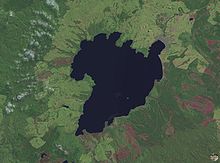
Satellite photo of Lake Taupō - Cerberean Cauldron (Australia)
- Dakataua (Papua New Guinea)
- Kapenga (New Zealand)
- Kilauea (Hawaii, US)
- Lake Ohakuri (New Zealand)
- Lake Ōkataina (New Zealand)
- Lake Rotorua (New Zealand)
- Lake Taupō (New Zealand)
- Maroa (New Zealand)
- Moku‘āweoweo Caldera on Mauna Loa (Hawaii, US)
- Mount Warning (Australia)
- Prospect Hill (Australia)
- Rano Kau (Easter Island, Chile)
- Reporoa caldera (New Zealand)
- Antarctica
- Indian Ocean
Extraterrestrial volcanic calderas
- Mars
- Olympus Mons caldera
- Venus
- Maat Mons caldera
Erosion calderas
- Americas
- Guaichane-Mamuta (Chile)
- Mount Tehama (California, US)
- Europe
- Caldera de Taburiente (Spain)
- Oceania
- Tweed Valley (New South Wales, Queensland, Australia)
- Asia
- Chegem Caldera (Kabardino-Balkarian Republic, Northern Caucasus Region, Russia)
- Taal volcano (Philippines) Batangas Province
See also
- Complex volcano – Landform of more than one related volcanic centre
- Maar – Low-relief volcanic crater
- Somma volcano – Volcanic caldera that has been partially filled by a new central cone
- Supervolcano – Volcano that has had an eruption with a volcanic explosivity index (VEI) of 8
- Volcanic Explosivity Index – Predictive Qualitative scale for explosiveness of volcanic eruptionsPages displaying short descriptions of redirect targets
Explanatory notes
- Leopold von Buch's book Physical Description of the Canary Isles was published in 1825.
References
- "caldera". Dictionary.com Unabridged (Online). n.d.
- Troll, V. R.; Walter, T. R.; Schmincke, H.-U. (1 February 2002). "Cyclic caldera collapse: Piston or piecemeal subsidence? Field and experimental evidence". Geology. 30 (2): 135–38. Bibcode:2002Geo....30..135T. doi:10.1130/0091-7613(2002)030<0135:CCCPOP>2.0.CO;2. ISSN 0091-7613.
- ^ Gudmundsson, Magnús T.; Jónsdóttir, Kristín; Hooper, Andrew; Holohan, Eoghan P.; Halldórsson, Sæmundur A.; Ófeigsson, Benedikt G.; Cesca, Simone; Vogfjörd, Kristín S.; Sigmundsson, Freysteinn; Högnadóttir, Thórdís; Einarsson, Páll; Sigmarsson, Olgeir; Jarosch, Alexander H.; Jónasson, Kristján; Magnússon, Eyjólfur; Hreinsdóttir, Sigrún; Bagnardi, Marco; Parks, Michelle M.; Hjörleifsdóttir, Vala; Pálsson, Finnur; Walter, Thomas R.; Schöpfer, Martin P. J.; Heimann, Sebastian; Reynolds, Hannah I.; Dumont, Stéphanie; Bali, Eniko; Gudfinnsson, Gudmundur H.; Dahm, Torsten; Roberts, Matthew J.; Hensch, Martin; Belart, Joaquín M. C.; Spaans, Karsten; Jakobsson, Sigurdur; Gudmundsson, Gunnar B.; Fridriksdóttir, Hildur M.; Drouin, Vincent; Dürig, Tobias; Aðalgeirsdóttir, Guðfinna; Riishuus, Morten S.; Pedersen, Gro B. M.; van Boeckel, Tayo; Oddsson, Björn; Pfeffer, Melissa A.; Barsotti, Sara; Bergsson, Baldur; Donovan, Amy; Burton, Mike R.; Aiuppa, Alessandro (15 July 2016). "Gradual caldera collapse at Bárdarbunga volcano, Iceland, regulated by lateral magma outflow" (PDF). Science. 353 (6296): aaf8988. doi:10.1126/science.aaf8988. hdl:10447/227125. PMID 27418515. S2CID 206650214. Archived (PDF) from the original on 24 July 2018.
- Shelly, D.R.; Thelen, W.A. (2019). "Anatomy of a Caldera Collapse: Kīlauea 2018 Summit Seismicity Sequence in High Resolution". Geophysical Research Letters. 46 (24): 14395–14403. Bibcode:2019GeoRL..4614395S. doi:10.1029/2019GL085636. S2CID 214287960.
- ^ Cole, J; Milner, D; Spinks, K (February 2005). "Calderas and caldera structures: a review". Earth-Science Reviews. 69 (1–2): 1–26. Bibcode:2005ESRv...69....1C. doi:10.1016/j.earscirev.2004.06.004.
- ^ Smith, Robert L.; Bailey, Roy A. (1968). "Resurgent Cauldrons". Geological Society of America Memoirs. 116: 613–662. doi:10.1130/MEM116-p613.
- von Buch, L. (1820). Ueber die Zusammensetzung der basaltischen Inseln und ueber Erhebungs-Cratere. Berlin: University of Lausanne. Retrieved 28 December 2020.
- Greshko, Michael (8 April 2016). "201 Years Ago, This Volcano Caused a Climate Catastrophe". National Geographic. National Geographic. Retrieved 2 September 2020.
- "Piton de la Fournaise". Global Volcanism Program. Smithsonian Institution. 2019.
- ^ Philpotts, Anthony R.; Ague, Jay J. (2009). Principles of igneous and metamorphic petrology (2nd ed.). Cambridge, UK: Cambridge University Press. ISBN 9780521880060.
- Dethier, David P.; Kampf, Stephanie K. (2007). Geology of the Jemez Region II. Ne Mexico Geological Society. p. 499 p. Archived from the original on 17 October 2015. Retrieved 6 November 2015.
- John, D. A. (1 February 2008). "Supervolcanoes and Metallic Ore Deposits". Elements. 4 (1): 22. doi:10.2113/GSELEMENTS.4.1.22.
- "UMD: Precambrian Research Center". University of Minnesota, Duluth. Archived from the original on 4 March 2016. Retrieved 20 March 2014.
- Ron Morton. "Caldera Volcanoes". University of Minnesota, Duluth. Retrieved 3 July 2015.
- Steven, Thomas A.; Luedke, Robert G.; Lipman, Peter W. (1974). "Relation of mineralization to calderas in the San Juan volcanic field, southwestern Colorado". J. Res. US Geol. Surv. 2: 405–409.
- Schmincke, Hans-Ulrich (2003). Volcanism. Berlin: Springer. pp. 42–43. ISBN 9783540436508.
- Schmincke 2003, pp. 155–157.
- Schmincke 2003, p. 157.
- Lowenstern, Jacob B.; Christiansen, Robert L.; Smith, Robert B.; Morgan, Lisa A.; Heasler, Henry (10 May 2005). "Steam Explosions, Earthquakes, and Volcanic Eruptions—What's in Yellowstone's Future? – U.S. Geological Survey Fact Sheet 2005–3024". United States Geological Survey.
{{cite journal}}: Cite journal requires|journal=(help) - "What's the Biggest Volcanic Eruption Ever?". livescience.com. 10 November 2010. Retrieved 1 February 2014.
- Best, Myron G.; Christiansen, Eric H.; Deino, Alan L.; Gromme, Sherman; Hart, Garret L.; Tingey, David G. (August 2013). "The 36–18 Ma Indian Peak–Caliente ignimbrite field and calderas, southeastern Great Basin, USA: Multicyclic super-eruptions". Geosphere. 9 (4): 864–950. Bibcode:2013Geosp...9..864B. doi:10.1130/GES00902.1.
- ^ Troll, Valentin R.; Emeleus, C. Henry; Donaldson, Colin H. (1 November 2000). "Caldera formation in the Rum Central Igneous Complex, Scotland". Bulletin of Volcanology. 62 (4): 301–317. Bibcode:2000BVol...62..301T. doi:10.1007/s004450000099. ISSN 1432-0819. S2CID 128985944.
- Best, Myron G.; Christiansen, Eric H.; Deino, Alan L.; Grommé, C. Sherman; Tingey, David G. (10 December 1995). "Correlation and emplacement of a large, zoned, discontinuously exposed ash flow sheet: The 40 Ar/ 39 Ar chronology, paleomagnetism, and petrology of the Pahranagat Formation, Nevada". Journal of Geophysical Research: Solid Earth. 100 (B12): 24593–24609. Bibcode:1995JGR...10024593B. doi:10.1029/95JB01690.
- Cook, Geoffrey W.; Wolff, John A.; Self, Stephen (February 2016). "Estimating the eruptive volume of a large pyroclastic body: the Otowi Member of the Bandelier Tuff, Valles caldera, New Mexico". Bulletin of Volcanology. 78 (2): 10. Bibcode:2016BVol...78...10C. doi:10.1007/s00445-016-1000-0. S2CID 130061015.
- Grocke, Stephanie B.; Andrews, Benjamin J.; de Silva, Shanaka L. (November 2017). "Experimental and petrological constraints on long-term magma dynamics and post-climactic eruptions at the Cerro Galán caldera system, NW Argentina". Journal of Volcanology and Geothermal Research. 347: 296–311. Bibcode:2017JVGR..347..296G. doi:10.1016/j.jvolgeores.2017.09.021.
- Tizzani, P.; Battaglia, M.; Castaldo, R.; Pepe, A.; Zeni, G.; Lanari, R. (April 2015). "Magma and fluid migration at Yellowstone Caldera in the last three decades inferred from InSAR, leveling, and gravity measurements". Journal of Geophysical Research: Solid Earth. 120 (4): 2627–2647. Bibcode:2015JGRB..120.2627T. doi:10.1002/2014JB011502.
- Schaller, N; Griesser, T; Fischer, A; Stickler, A. and; Brönnimann, S. (2009). "Climate effects of the 1883 Krakatoa eruption: Historical and present perspectives". VJSCHR. Natf. Ges. Zürich. 154: 31–40. Retrieved 29 December 2020.
- Robock, A. (15 February 2002). "PINATUBO ERUPTION: The Climatic Aftermath". Science. 295 (5558): 1242–1244. doi:10.1126/science.1069903. PMID 11847326. S2CID 140578928.
- Kisvarsanyi, Eva B. (1981). Geology of the Precambrian St. Francois Terrane, Southeastern Missouri. Missouri Department of Natural Resources, Division of Geology and Land Survey. OCLC 256041399.
- Goff, Fraser; Gardner, Jamie N.; Reneau, Steven L.; Kelley, Shari A.; Kempter, Kirt A.; Lawrence, John R. (2011). "Geologic map of the Valles caldera, Jemez Mountains, New Mexico". New Mexico Bureau of Geology and Mineral Resources Map Series. 79. Bibcode:2011AGUFM.V13C2606G. Retrieved 18 May 2020.
- Ross, Clarence S.; Smith, Robert L. (1961). "Ash-flow tuffs: Their origin, geologic relations, and identification". U.S. Geological Survey Professional Paper. Professional Paper. 366. doi:10.3133/pp366.
- "Stanley Ambrose page". University of Illinois at Urbana-Champaign. Retrieved 20 March 2014.
- Supervolcanoes, BBC2, 3 February 2000
- Gathorne-Hardy, F.J; Harcourt-Smith, W.E.H (September 2003). "The super-eruption of Toba, did it cause a human bottleneck?". Journal of Human Evolution. 45 (3): 227–230. doi:10.1016/s0047-2484(03)00105-2. PMID 14580592.
- Petraglia, M.; Korisettar, R.; Boivin, N.; Clarkson, C.; Ditchfield, P.; Jones, S.; Koshy, J.; Lahr, M. M.; Oppenheimer, C.; Pyle, D.; Roberts, R.; Schwenninger, J.-L.; Arnold, L.; White, K. (6 July 2007). "Middle Paleolithic Assemblages from the Indian Subcontinent Before and After the Toba Super-Eruption". Science. 317 (5834): 114–116. Bibcode:2007Sci...317..114P. doi:10.1126/science.1141564. PMID 17615356. S2CID 20380351.
- "EO". Earthobservatory.nasa.gov. 23 December 2013. Retrieved 20 March 2014.
- "Fernandina: Photo". Global Volcanism Program. Smithsonian Institution.
- ^ Parfitt, L.; Wilson, L. (19 February 2008). "Volcanism on Other Planets". Fundamentals of Physical Volcanology. Malden, MA: Blackwell Publishing. pp. 190–212. ISBN 978-0-632-05443-5. OCLC 173243845.
- Gudmundsson, Agust (2008). "Magma-Chamber Geometry, Fluid Transport, Local Stresses and Rock Behaviour During Collapse Caldera Formation". Caldera Volcanism: Analysis, Modelling and Response. Developments in Volcanology. Vol. 10. pp. 313–349. doi:10.1016/S1871-644X(07)00008-3. ISBN 978-0-444-53165-0.
- Chauhan, M.; Bhattacharya, S.; Saran, S.; Chauhan, P.; Dagar, A. (June 2015). "Compton–Belkovich Volcanic Complex (CBVC): An ash flow caldera on the Moon". Icarus. 253: 115–129. Bibcode:2015Icar..253..115C. doi:10.1016/j.icarus.2015.02.024.
- Philip's World Reference Atlas including Stars and Planets ISBN 0-7537-0310-6 Publishing House Octopus publishing Group Ltd p. 9
- "Borrowdale Volcanic Group, upper silicic eruptive phase, Caradoc magmatism, Ordovician, Northern England – Earthwise".
- Clemens, J.D.; Birch, W.D. (December 2012). "Assembly of a zoned volcanic magma chamber from multiple magma batches: The Cerberean Cauldron, Marysville Igneous Complex, Australia". Lithos. 155: 272–288. Bibcode:2012Litho.155..272C. doi:10.1016/j.lithos.2012.09.007.
Further reading
- Clough, C. T.; Maufe, H. B.; Bailey, E. B. (1909). "The Cauldron-Subsidence of Glen Coe, and the Associated Igneous Phenomena". Quarterly Journal of the Geological Society. 65 (1–4): 611–78. doi:10.1144/GSL.JGS.1909.065.01-04.35. S2CID 129342758.
- Gudmundsson, Agust (2008). "Magma-Chamber Geometry, Fluid Transport, Local Stresses and Rock Behaviour During Collapse Caldera Formation". Caldera Volcanism: Analysis, Modelling and Response. Developments in Volcanology. Vol. 10. pp. 313–349. doi:10.1016/S1871-644X(07)00008-3. ISBN 978-0-444-53165-0.
- Kokelaar, B. P; and Moore, I. D; 2006. Glencoe caldera volcano, Scotland. ISBN 9780852725252. Pub. British Geological Survey, Keyworth, Nottinghamshire. There is an associated 1:25000 solid geology map.
- Lipman, P; 1999. "Caldera". In Haraldur Sigurdsson, ed. Encyclopedia of Volcanoes. Academic Press. ISBN 0-12-643140-X
- Williams, Howell (1941). "Calderas and their origin". University of California Publications Bulletin of the Department of Geological Sciences. 25: 239–346.
External links
- USGS page on calderas
- List of Caldera Volcanoes
- Collection of references on collapse calderas (43 pages)
- The Caldera of the Tweed Volcano – Australia
- Largest Explosive Eruptions: New results for the 27.8 Ma Fish Canyon Tuff and the La Garita caldera, San Juan volcanic field, Colorado
- Supervolcanoes
- Time-lapse video of Kīlauea caldera collapse, 2018
| Earth's landforms | |
|---|---|
| List of landforms | |
| Mountainous | |
| Continental plain | |
| Fluvial | |
| Glacial | |
| Oceanic and coastal landforms | |
| Volcanic | |
| Aeolian | |
| Artificial | |
| |

